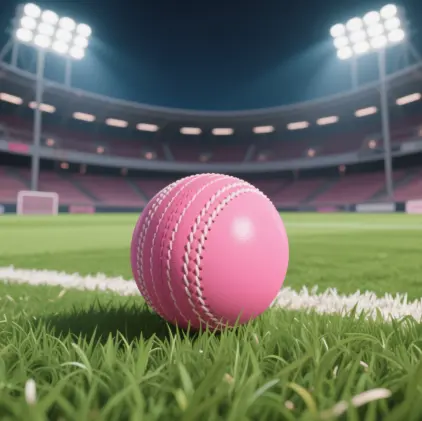Cricket is a very old game with the history of centuries, experts say it has originated in the 13th century and has evolved greatly since its birth, with day-night cricket being one of the innovations that provided a new platform to the game. Among the innovations is the application of the pink ball, designed to address low visibility under floodlights.

Cricket is not a game which can be finished in an hour or two, most of the matches takes a lot longer and sometimes it exceeds from day to night too, such as the Test matches usually takes 5 days and there are some Tests which are day-and-night. The traditional red ball for Test game is sometime hard to see during floodlights so the invention of Pink Ball came into being and gave a new color to cricket. The Pink coated layer in this ball became the reason of visibility under the floodlights and bad weather.
In most of the matches, red and white ball is used but the pink ball is only played for day-night Test matches and limited-overs cricket. White balls, played for ODIs and T20s, are worn out too soon for the longer game, and red balls used in traditional form are not visible in floodlights. The pink ball was thus invented as a middle ground, being visible enough in poor light and also hardy enough for Test cricket.
Day-night Tests have become more popular after the first such match in 2015 when at Adelaide Oval, Australia hosted New Zealand. Several countries have since then conducted pink-ball Tests in a bid to obtain larger audiences by allowing play to extend into the evening.
Pink ball was initially experimented with in the early 2000s. But it took until 2015 for the ICC to officially announce its use in Test matches. The greatest challenge was to make the ball visible under lights and yet not lose its life quickly.
The pink ball was put through tough tests in home competitions like Australia's Sheffield Shield prior to going global. There were companies like Kookaburra, Dukes, and SG making variations with lacquer added to maintain sheen and visibility. The initial day-night Test in 2015 was the turning point and established that the pink ball is able to achieve international standards.
There are a lot of differences in the appearance and also in the performance such as visibility, color, durability, swing and seam movement. The luminous pink color of the pink ball improves visibility in lights over red, which browns out or white, which bleaches out. It has a black seam, a lacquered finish for durability, and swings further under lights. It does not color off as quickly as white balls, while its tougher seam helps spinners in the tail of innings.
| Feayure | Pink Ball | Red Ball | White Ball |
| Use | Day-night Tests | Day Tests | ODIs & T20s |
| Visibility | Best under lights | Poor under lights | Good but fades fast |
| Durability | High | Very high | Low |
| Swing | More swing under lights | Balanced | Less swing |
| Finish | Shiny (lacquered) | Natural leather | Scuffs easily |
The pink ball gives improved light visibility, facilitates play extending into the evenings for bigger crowds, and endures longer than white balls, hence it is appropriate for Tests. The pink ball also revolutionizes cricket by providing day-night games, bringing excitement into the traditional form without dampening interest among the players and spectators.
Also Check:
Cricket Ball Weight and Size Explained
IPL Cricket Ball Price Revealed
The pink ball has disadvantages: it is unpredictable, preferring seamers in light conditions. Dew impacts grip, lowering swing and making fielding difficult. It has not been widely adopted yet, with most preferring to play with standard balls. Batsmen also find batting against its overplay during dusk conditions difficult, despite its advantages.